Designing for Cultural Experiences

AYERS SAINT GROSS


AYERS SAINT GROSS



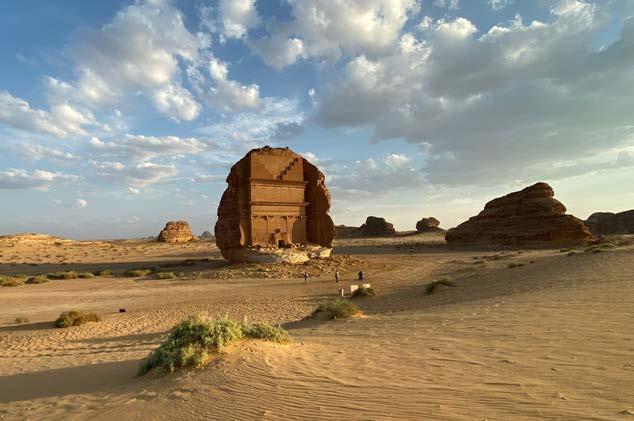

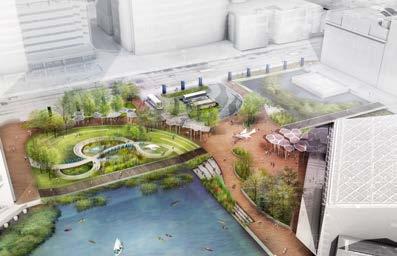








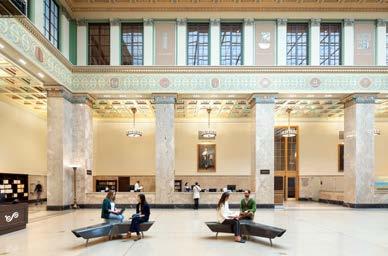





Immersive cultural spaces translate mission into the built environment.




Curated design details honor a site’s unique identity, history, and place.




We guide projects from vision to reality, balancing beauty, performance, experience, and operations.
Ayers Saint Gross is an internationally recognized design firm that works with mission-driven clients to create places for shared knowledge and culture. Our work is driven by a respect for past wisdom, a mind to future potential, and an obligation to leave places better than we found them.
Services
Architecture
Graphic Design
Interiors
Landscape Architecture
Planning
Space Analytics
Ayers Saint Gross designers work with a diverse range of cultural organizations and institutions including museums, libraries, visitor centers, educational institutions, and cultural landscapes to create immersive experiences of engagement and discovery.
We understand that every institution is driven by its own unique story, mission, and goals. Our interdisciplinary team works with clients to learn and understand those messages and define project principles and a narrative that will inform an entire project, taking into consideration accessibility, sustainability, and the visitor experience. We explore opportunities for creative, of-the-moment storytelling within landscape and buildings, while providing a framework for long-term evolution and flexibility.
We believe in the collective wisdom of a facilitated, inclusive design process. We ask hard questions and seek many perspectives to guide our clients toward a shared vision.

We shape long-term investments in the built environment by creating places of enduring value.

We are creative problem solvers, without a prescriptive approach. We begin with research and commit to intellectual rigor throughout the life of every project.

We bring together deep expertise across multiple disciplines to express beauty and innovation.

Thoughtful details ground us in place. Scale and proportion create pattern and rhythm. Materials provide form, color, and texture to enrich the visitor experience.


Thoughtfully designed spaces inspire visitors and encourage them to learn and engage in both large and subtle ways. One-of-a-kind details and design elements can speak to a site’s unique location, heritage, and history. By making careful decisions about site, architecture, landscape, materials, graphics, and more, we craft richly layered environments that visitors will want to revisit.
The Jack C. Taylor Visitor Center at the Missouri Botanical Garden takes inspiration from the history of the Garden and its extensive plant collection, creating an immersive experience by incorporating biophilic elements. From visitors’ arrival through a historic stone garden wall, they are surrounded with a wide range of locally sourced materials and garden-inspired elements, including a custom-designed scrim inspired by tree canopies, custom terrazzo flooring with inlays of local river rock and brass accents reflecting the native Missouri woodland, and furniture forms influenced and inspired by rounded rocks and pebbles. The result is an experience that speaks to the mission of the Garden, inspiring awe and wonder at the natural world.
At Stono Preserve in South Carolina’s Lowcountry, we highlight both the ecological importance of the landscape and its rich history through the interpretation of specimen trees, key vistas, architectural details, and preserved buildings. Trails are designed to meet accessibility guidelines without compromising the existing terrain or wildlife habitats. Interpretive signage teaches visitors about natural and historical features, including archaeological sites and native habitats.




The Missouri Botanical Garden in St. Louis, Missouri is a global leader in plant science research and the nation’s oldest botanical garden in continuous operation. Annually, more than one million visitors from around the world travel to the Missouri Botanical Garden to immerse themselves in the calming, beautiful presence of nature.
When Ayers Saint Gross was selected to design the Garden’s new Jack C. Taylor Visitor Center, we wanted to embrace and celebrate that experience by incorporating elements of the natural world into the design wherever possible. This concept, known as biophilic design, uses elements of nature — sunlight and plants or natureinspired color and shapes — to create a calming environment that both engages and inspires visitors.




and ample sunlight.
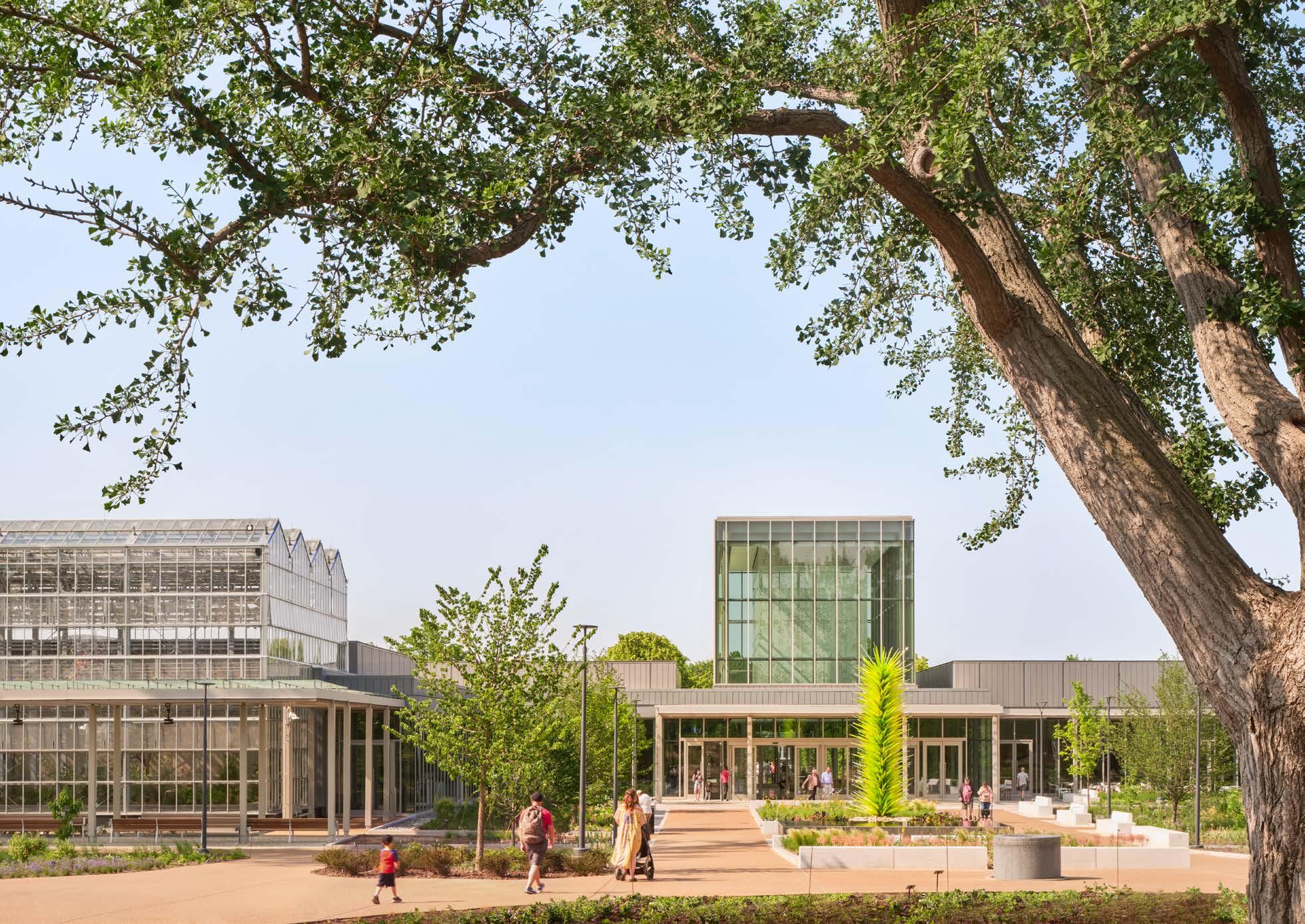
First and most crucially, the visitor center embraces biophilic design by complementing and displaying the Garden’s living collections. Before entering the visitor center, guests walk through a series of paths within new entry gardens designed in partnership with Michael Vergason Landscape Architects. A spacious plaza, wide walkways, and seating areas allow visitors to admire the landscape before entering the building.
Inside the building, floor-to-ceiling windows provide immediate views of nature. The center’s shape and orientation was designed to connect visitors with the Garden while creating memorable spaces inside and out. We did not want visitors to see the center as something separate from the Garden itself, but rather as an extension of the overall Garden experience.




A standout element of the lobby design is a lantern feature suspended from above that includes a customdesigned “scrim” perforated in a pattern inspired by the Garden’s specimen Ginkgo tree. By providing dappled light into the lobby, the scrim replicates the light quality found in a forest clearing. The scrim was carefully detailed to balance beauty and functionality, transforming the quality of light while also reducing direct sunlight and glare over key visitor areas like the ticketing desk. The scrim encourages visitors to pause and reflect on the scale and importance of the work being done at the Garden — the thousands of species housed, discovered, and named there — and the impact the institution has in the community and globally.

































In addition to the direct elements of plants and sunlight, our team incorporated biophilic elements throughout several aspects of the interior design. A terrazzo floor was designed with hand-laid inlays of local river rock, stones, and brass accents of custom tree leaves, appearing as if they have fallen from the canopy above.





Custom illustrated leaves are replicated from Garden specimens. Detailed drawings provided a map for installation of the terrazzo inlays.




The ticketing and visitor engagement desk forms are inspired by the shapes of rounded rocks and pebbles, with bud vases recessed in the counters to hold cuttings of plants in bloom. Sustainable lighting pendants above provide a luminescent sparkle similar to that of fireflies or droplets of rain.
Walls dividing the dining areas and café include pressed botanical specimens from the Garden’s collection, while the overhead lighting mimics the form of roses in full bloom. The dining area, designed in partnership with Tao + Lee, includes a statement seating bench made from the trunk of a Shumard Oak. This tree had previously been part of the Garden’s living collection before reaching the end of its natural life span.
Beyond its biophilic inspiration, the visitor center is designed to be environmentally sensitive by preserving resources and reducing carbon emissions wherever possible. Solar shading, interior and exterior ventilation, rooftop solar panels, and rainwater displacement design elements ensure that the Jack C. Taylor Visitor Center reflects the Garden’s overall mission and sustainability goals while pursuing LEED Gold certification.
Scope and Services
• Architecture
• Graphic Design
• Interiors Awards
• IIDA Southwest Best in Show
• IIDA Southwest Design Excellence Award for Public Facilities
Stories are the legacy of our cultural and educational institutions and the fabric of our communities. Immersive cultural spaces communicate through the built environment, sharing a resonant, cohesive narrative that visitors remember.

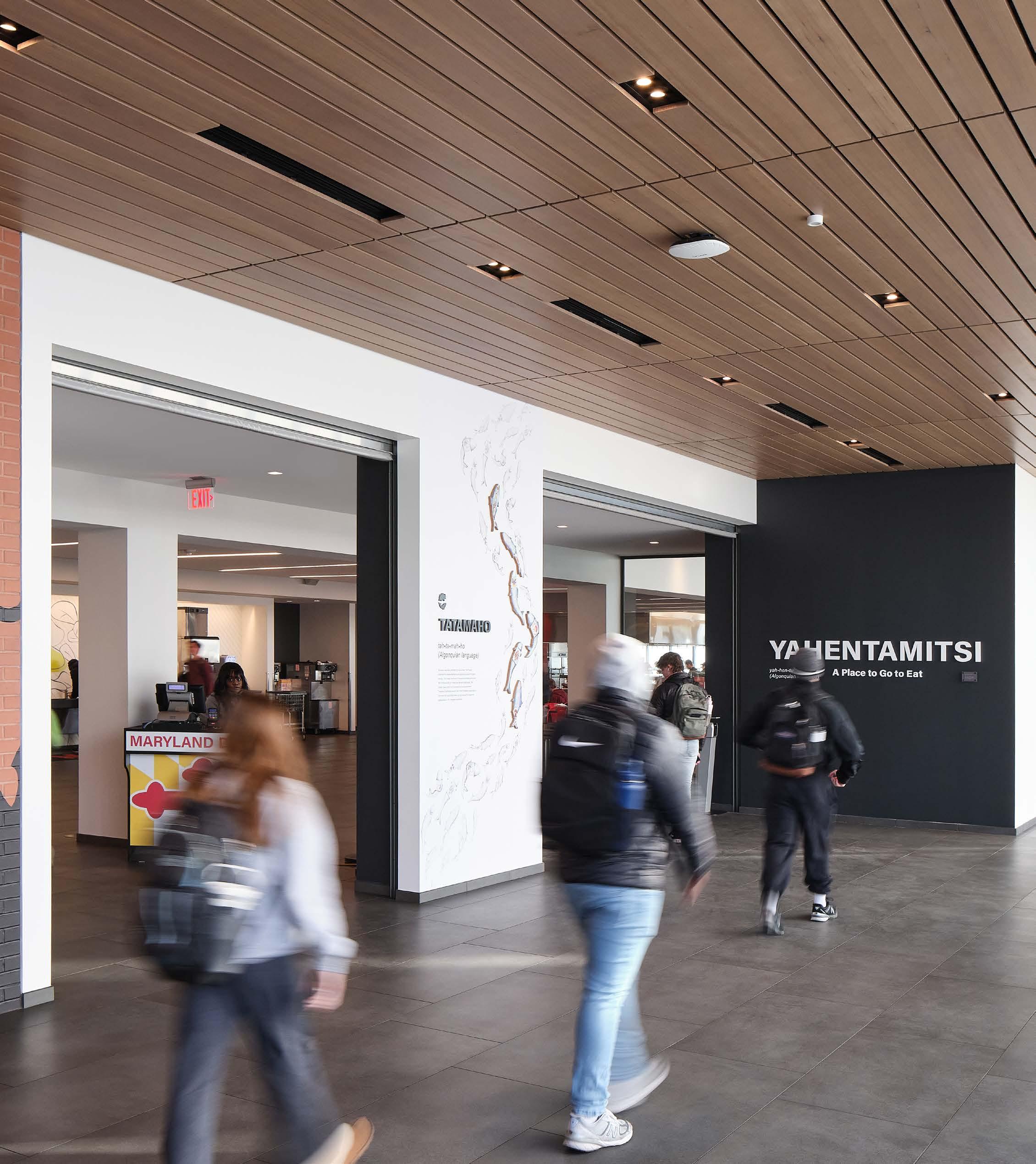
Great storytellers reveal truths by listening to the voices of those who have experienced the spirit of a place and its history. We identify the symbols, points of resonance, and layers of knowledge that help us to interpret and share stories in a memorable, relevant way. By integrating inspiration and information in unexpected ways, we create spaces that meet visitors where they are.
At the University of Maryland Yahentamitsi Dining Hall, our team was asked to imbue the building with a deeper sense of history and a celebration of the cultural diversity of the university, as well as those indigenous to the area. We worked directly with members of the Piscataway Tribe to develop exhibition content, sourcing images and graphics to ensure respectful representation of their culture and a comprehensive history of their tribe.


At the National Aquarium on Baltimore’s Inner Harbor, we worked with the aquarium to develop Harbor Wetland, a floating wetland which is both a mechanism to provide safe habitat and a tool for teaching visitors about the role wetlands play in fostering biodiversity. A learning dock brings visitors close to the display, allowing them to be immersed in the exhibit in a meaningful and personal way.
Ayers Saint Gross worked with the University of Maryland to design a new residential village consisting of the Johnson-Whittle and Pyon-Chen Residence Halls and the Yahentamitsi Dining Hall. The University named their newly designed Yahentamitsi Dining Hall in recognition of the Piscataway Conoy Tribe, upon whose land the University of Maryland sits. “Yahentamitsi” translates to “A Place to Go to Eat” in the native Algonquian language.
Wanting the recognition to go beyond simply a name, the university asked us to create environmental graphics that weave throughout the entire facility, offering a comprehensive history of the tribe and its stories through authentic perspectives, voices, and artwork.




Environmental graphics provide information about Piscataway trade routes, folklore, and values.
We worked closely with the university, as well as elders of the Piscataway Conoy Tribe throughout this iterative process to ensure an outcome of which everyone would be proud. It was an honor and privilege to learn from the Piscataway elders and to offer a canvas for their authentic stories to be told.
Throughout the design process we focused on relationship-building between the university and tribal government. Through a series of conversations and firsthand accounts, we learned much about the Piscataway peoples and their philosophies surrounding food and the natural world.
Some of the main messages we heard from the Piscataway elders were about food as a shared gift that should be equitably distributed, and animal and plant relatives as individuals who should be honored in addition to human relatives. The elders expressed a desire to reclaim and share their robust culture and history.
We incorporated their history into all aspects of our design, beginning with the entrance of the dining hall, where a map of local waterways locates the 16 tribes of the Piscataway and displays the trade routes they used for more than 13,000 years.

































Next, visitors are met with the legend of the shad fish, featuring original artwork by an indigenous artist. In an effort to highlight Piscataway voices, we incorporated the Algonquian language on each wall. And while all designs provided by our team are displayed in black and white, elements contributed by the Piscataway are integrated proudly in full color.
Throughout the dining hall, we wove information about gathering cycles and the Seven Grandfathers who the tribes believe were sent by the Creator to watch over them. A hand-painted mural commissioned by a local indigenous artist completes the experience, illustrating the story of the gathering cycles.



Additional tribal history is shown on the lower level of the building (also, the entrance of the Honors College), including a comprehensive timeline, through current day.
Originally we envisioned a feature of this wall as an immersive treaty wall with a collection of written treaties. After the tribe elders explained that treaties were written by colonizers and amounted to a series of broken promises, we proposed swapping imagery of written treaties with imagery of wampum belts. These intricately hand-beaded belts are symbols of historic moments in the Piscataway culture. This shift allowed this important piece of history to be told through Piscataway voices.
This project is a great example of how environmental design can raise public awareness in a meaningful way. It is also just the beginning of the ways the University of Maryland plans to recognize the Piscataway peoples. Dining Services has already incorporated meal options consistent with the food and gathering cycles of the Piscataway Conoy Tribe. The university is also continuing its collaborations with the tribe by offering a course in Piscataway history and culture, led by eight tribe members.
Scope and Services
• Architecture
• Graphic Design
• Interiors
• Landscape Architecture Awards
• AIA Baltimore Excellence in Design Honorable Mention for Higher Education

The creative process evolves over time and across boundaries. We collaborate with our clients at every step — from strategic visioning to programming, design, and activation.


A Holistic Vision
The creative process is one of evolution and growth. We tackle complex problems holistically by forming strong relationships, learning together, and reflecting and responding to evolving project needs over time. We pride ourselves on supporting our clients in the longterm in a trusted advisor role, carrying projects through multiple stages from visioning to implementation and construction.
Ayers Saint Gross is honored to have worked with the Smithsonian Institution since 2010 on a variety of planning, programming, and architectural projects. In our work for the Institution’s two newest museums (the National Museum of the American Latino and the American Women’s History Museum) we used online polls, virtual town halls, and on-site tours to both broaden participation and deepen the discussion regarding the physical, symbolic, and operational goals of project program and site selection.
Over the course of the last decade, we have also worked closely with the Smithsonian Institution to develop their Collections Framework Plan, which cataloged their collections space needs, and has led to the design and construction of nearly 500,000 square feet of collections space. We continue to work with the Smithsonian Institution to develop plans that allow for the growth of their collections for near-term and long-term needs.
Our architects and planners have spent years engaged with the Royal Commission for AlUla, on projects related to the Archaeology Research Institute AlUla (Kingdoms Institute), and the programming and planning of numerous galleries and other high profile cultural assets. We have also developed the detailed master plan for Wadi AlFann, a permanent “arts in the landscape” venue located in the desert canyons of Saudi Arabia.
As part of the Wadi AlFann master plan, we’ve spent hundreds of hours on the ground and utilized multiple techniques in mapping the 15-square-mile site to develop a deep expertise of the geography and its complex landscape. Given our knowledge of the site and vision, we were asked to take on a stewardship role for the site and continue to guide the vision and development going forward.


We believe that places for art and culture are fundamental to an enriched and enlightened society. This commitment has found fertile ground in the development efforts shaping our work in the Saudi Arabian desert region of AlUla and our collaboration with the Royal Commission for AlUla (RCU). For more than five years, we have worked together on an ambitious endeavor to establish AlUla as a global destination, leveraging its status as one of the world’s most remarkable preserved archaeological landscapes, with sites dating back 250,000 years.
RCU’s vision for AlUla encompasses a comprehensive array of initiatives spanning archaeology, tourism, culture, education, and the arts, all aimed at delivering an unparalleled visitor experience. Our work with RCU is rooted in a profound appreciation of the varied landscapes of AlUla, the area’s rich heritage, and a shared sense of opportunity and vision. This blend of reverence for tradition and enthusiasm for contemporary expression has spurred the creation of diverse and impactful cultural experiences emerging from geological transformation, ecological protection and preservation, archaeological investigations, and artistic legacies.

When we look at the night sky, we all see a world of our own, a reflection, an imprint of memory, a mirror of our aspirations, deep-seated longings from our collective pasts and an embodiment of our individual hopes for the future.

AlUla is all of these, and the stars above and upon its grounds are an endless inspiration — a universe of experiences — upon which we can all draw our own constellation.
Our journey began as an extension of another longterm relationship – the 12 years we spent designing and implementing the preservation, interpretation, and visitor experience at the Atturaif Living Museum, a UNESCO World Heritage Site. Our reputation managing the complexity and sensitivity of heritage development with creativity and practicality led to a request by RCU to program and plan an institutional framework for its growing archaeological programs.
To establish this framework, we meticulously researched more than 50 archaeological institutes worldwide, examining their research focus, organizational structure, and day-to-day operations. Through site visits and evaluations of peer facilities, we gained insights into the design and functionality of their workspaces, laboratories, collections, and communal spaces. Our goal was to understand the strengths and weaknesses of their organizations and operations, in order to identify key factors that could contribute to or hinder the success of a future institution in AlUla. Our findings, which included opportunities in the organizational overlap between archaeological programs, contemporary art collecting initiatives, and the future visitor experience, laid the groundwork for many of the cultural initiatives taking shape in AlUla today.
ARCHAEOLOGISTS
8
BENCHMARK VISITS
27
PERSONNEL DAYS ON SITE
KINGDOM MUSEUM
LANGUAGE BELIEFS
TRADE
ARCHITECTURE TRADE OPENNESS
DADAN VISITOR CENTRE
BELIEFS
ARTS DISTRICT PRESENTING TRAINING MAKING CREATIVITY COMMUNITY VITALITY
GEOGRAPHY AGRICULTURE
HISTORY
HYDROLOGY
SUSTAINABILITY
COMMUNITY
OASIS LIVING GARDENS
RITUAL LITHICS
PLANT SCIENCE
GARDENS
FOOD
GATHERING EDUCATION AGRICULTURE
LANGUAGE INTROSPECTION
JABAL IKMAH VISITOR CENTRE
QUIET
BAZAAR STORIES RECREATION EVENTS FOOD REST
INCENSE ROAD MARKET
PERSPECTIVES GALLERY SKYVIEWS LIFE & MEMORY GALLERIES
BEAUTY PEACE
MAPPING
TIME
SEEING CONSTELLATIONS
CRAFTS DESIGN PRODUCTION
MUSIC CREATION
TRANSFORMATIVE MONUMENTAL
WADI ALFANN MAJESTIC JOURNEYS TIMELESS INTERACTIVE
Early content map of AlUla’s Cultural Assets
TRADITIONS COMMUNITY PLAY STORYTELLING GENEOLOGY
NABATAEAN THEATRE
PERFORMANCE
BLACK BASALT MUSEUM
DAILY LIFE
ORIENTATION
HEGRA MUSEUM
VIRTUAL RECONSTRUCTION CULTURAL TRANSFER
WORLD VIEWS REFLECTION INNOVATIVE ART RITUAL
GEOLOGY CURIOSITY ART MYSTERY SPA INTERACTIVE
ART EXPRESSION
BREEDING
SILENCE NABATAEAN
CELEBRATIONS EVENTS
MOVEMENT
HOSPITALITY
BEAUTY
PEACE CREATION TRANQUILITY RIDING
SCENT RESTAURANT
INCENSE MUSEUM AND GARDENS
ARABIAN HORSE HERITAGE

After that first collaboration, the trust established empowered us to align seamlessly with RCU’s vision going forward. Working closely with our clients, we led a diverse expert team to craft a strategic framework encompassing organizational structure, operational guidelines, content development strategies, asset placement, and architectural standards for 16 distinctive heritage sites, museums, and educational institutions.
Drawing on research and community feedback, we delved into the unique characteristics of each site and institution, shaping proposals deeply rooted in the celebration of landscape, heritage, and the arts. Our design briefs for each site delineated design principles, spatial requirements, conceptual site and building relationships, architectural styles, sustainability objectives, preliminary engineering systems, and structural criteria.
Many of these assets have seen their initial visions evolve as we’ve continued to refine and expand upon them through bespoke programs and plans. This is critical in enabling our clients to move visions to the next phase of development for landmarks such as the Hegra Gateway, Museum of the Incense Road, The Contemporary Art Museum, Crossroads Gallery, Arts Foundation, Arts Academy, and Wadi AlFann, ensuring that each contributes uniquely to the cultural tapestry of AlUla.


As architects and planners, we are keenly aware of the profound impact our collaboration with RCU has had and continues to have on shaping the future of Wadi AlFann, aptly known as the “Valley of the Arts.” Situated amidst the desert canyons of AlUla, this ambitious, permanent art venue will serve as a one-of-a-kind showcase for world-renowned contemporary land artists, while spanning an impressive 15 square miles of desert landscape.


When RCU entrusted us with the task of developing the master plan for Wadi AlFann, what began as an exciting prospect soon unfolded into a multifaceted endeavor of monumental proportions. Because Wadi AlFann spans an area of 3,900 hectares, the master plan demanded meticulous coordination of a complex group of stakeholders, external development, and internal infrastructure. The goal was to ensure an “everything speaks” environment that would allow visitors to become completely immersed in nature, heritage, and art. This included the strategic identification and placement of vital visitor amenities including pavilions, comfort stations, beacons, and gatehouses. Our team also worked on designating and positioning artist sites, mapping and delineating an extensive trail network and programming the seamless operation of daily visits to the site.
As the Wadi AlFann master plan continues to evolve, we are still working closely with RCU to provide operational guidance and compliance with land use regulations and sustainability initiatives. As stewards of this visionary project, we remain committed to realizing RCU’s bold vision for Wadi AlFann and preserving its essence as a testament to the harmonious convergence of art, heritage, and nature.

Ayers Saint Gross presents a collection of work that weaves together architecture and environment into rich cultural experiences that reveal and enrich the histories, contemporary lives, and legacy of people and place.
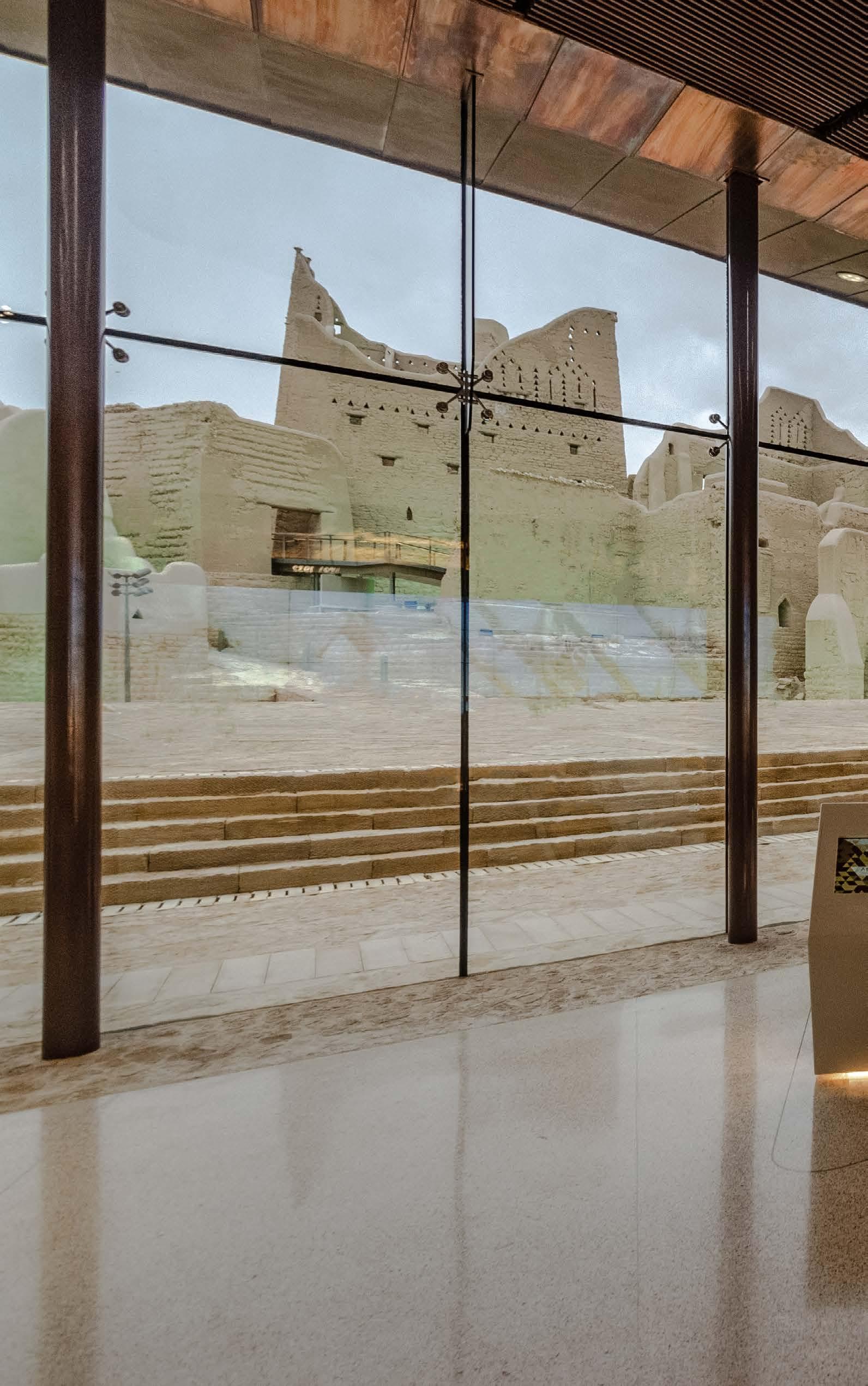

Re-imagined as an ecologically restorative landscape, the 2019 National Aquarium’s Waterfront Campus Plan advances the aquarium’s mission by creating a civic space where visitors are immersed in the natural systems and habitats of the Chesapeake Bay through environmental education, art, and recreation that inspires conservation action.
The Waterfront Campus Plan works to advance water quality and renew civic infrastructure. The project goals are to welcome and engage visitors, inspire conservation action, restore ecosystems, and serve as a living lab to foster community engagement. A series of immersive experience is proposed across the campus. Multi-sensory installations engage visitors on campus, connecting them with authentic Chesapeake Bay watershed habitats.
The project brings the National Aquarium’s conservation mission to the forefront with sustainable and high-performing floating wetland that improve water quality and support habitat diversity and resiliency. As part of the project, Ayers Saint Gross worked with Biohabitats, McLaren Engineers, Kovack, Whitney, and Associates in 2018 to design a sustainable floating wetland prototype as an extension of Studio Gang’s EcoSlip concept.
Scope and Services
• Landscape Architecture
• Landscape Planning
• Visitor Experience Awards
• AIA Maryland Excellence in Design for Urban Design and Master Planning Honor Award
• Maryland ASLA Merit Award








The National Aquarium has an ambitious mission to inspire conservation of the world’s aquatic treasures. With a prime location in Baltimore’s Inner Harbor and a goal of transforming their campus into a Chesapeake Bay demonstration landscape, the aquarium worked with Ayers Saint Gross to produce a sustainable and highperforming floating wetland to expand habitat on their campus. Located between Piers 3 and 4, the National Aquarium Harbor Wetland is a 10,000-square-foot habitat that allows visitors to immerse themselves in a salt marsh habitat like those that existed in the area hundreds of years ago. The free exhibit’s learning dock acts as a new civic anchor in the Inner Harbor, drawing visitors in to experience the wildlife that fills the harbor.
In addition to being a social space, the wetland utilizes over 30,000 grasses and shrubs combined with water aeration technology. Aquarium staff members and volunteers from the Baltimore community, including members of the Ayers Saint Gross landscape architecture team, spent time planting the grass and shrub specimens for the wetland. Once the plants mature, the exhibit will act as green infrastructure to promote healthy clean waters, attract native species, and provide a variety of habitats to support a strong ecosystem.
The project was born out of 2018 floating wetland prototype Ayers Saint Gross designed with the aquarium, in partnership with Biohabitats, McLaren Engineers, and Kovack, Whitney, and Associates as an extension of Studio Gang’s EcoSlip concept. The innovative construction ensures that this investment will far outlast conventional floating wetlands and become a landmark in the Inner Harbor.
The exhibit serves as a guide for future floating wetland projects in urban areas. It has been featured in media outlets around the globe, including Bloomberg CityLab, The Architect’s Newspaper, D5 Magazine, Building Design + Construction, and more.
Scope and Services
• Landscape Architecture
• Landscape Planning
• Visitor Experience Awards
• National ASLA Honor Award in Research for the Floating Wetlands Prototype

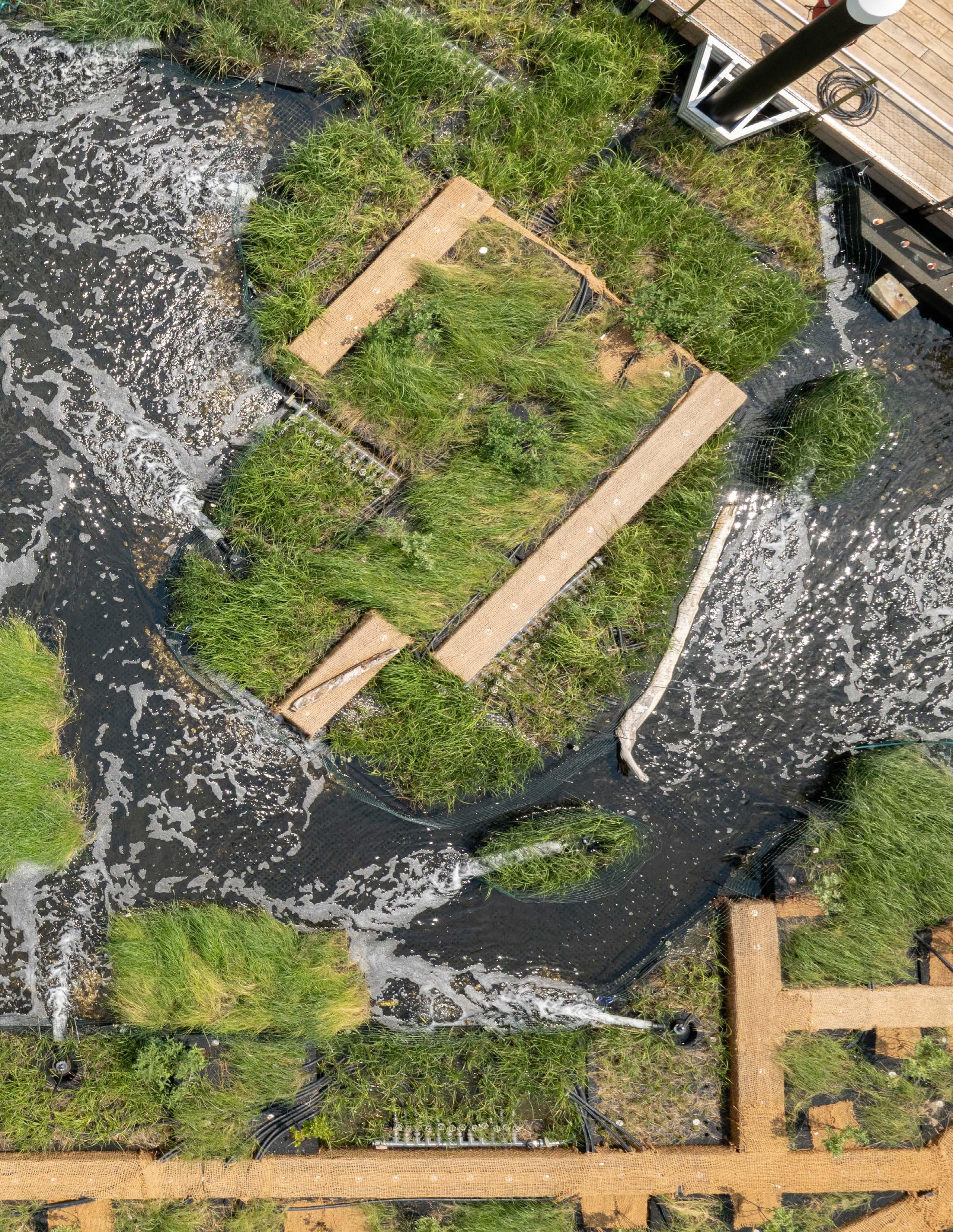
Sited on the banks of the Stono River and the Intercoastal Waterway, historic Stono Preserve is an ecological treasure of diverse landscapes. Ayers Saint Gross championed the concept of the 800-acre site as an environmental laboratory, developed the master plan, and implemented the nature trail, its interpretative signage system, renovated John Henry Dick studio, and a multipurpose meeting barn. The cyprus-sheathed barn serves as a hall for lectures, conferences, and social events. Sustainable design features include optimized energy performance, restored natural habitat, and reduced water consumption.
The project honors the diverse ecology of the site. It preserves landscapes and vernacular structures and creates educational and visitor facilities with minimal footprints on designated buildable sites. Trails follow guidelines for accessibility without compromising the existing terrain and habitats for migratory birds and other wildlife, using existing roads, the live oak allée, and a meandering connector path. Interpretive signage at key vistas teach students and visitors about natural and historic features, including archaeological sites and native Lowcountry habitats. With lightness and simplicity, the signs balance information with quiet, site-appropriate design.
Scope and Services
• Architecture
• Environmental Graphic Design
• Landscape Architecture
• Planning
• Programming
• Signage and Wayfinding
• Visitor Experience
Awards
• AIA Baltimore Excellence in Design Honorable Mention
• SCUP Excellence in Planning Honor Award for District or Campus Component
• AIA Maryland Excellence in Design Honor Award



Ayers Saint Gross developed a comprehensive master plan to guide the restoration of the natural setting to create a conservationist’s classroom for the college.



As the first phase of the complex, three-phased Jack C. Taylor Visitor Center project for the Missouri Botanical Garden, this temporary visitor center was constructed to replace the Garden’s normal visitor center operation while considering economy, sense of place, flexibility, and sustainability.
The design of the temporary interior space was conceived as a volumetric insert, carved to accommodate programmatic functions including ticketing, gift shops, educational outreach, restrooms, dining, and more. Upon completion of the permanent Jack C. Taylor Visitor Center, the volumetric insert was removed and reconfigured into a permanent event center.
Designed with sustainability in mind, materials chosen for the temporary visitor center were cost-effective and, often, reusable. A plan was established early for the reuse, repurpose, and recycling of many phase one fixtures, materials, and equipment that were dismantled after the visitor center operations moved into the final building.
Simple, authentic materials organized the space while birch plywood and botanical-inspired colors and graphics added interest, texture, and vibrancy. Intentionally placed color blocks, stencils, and applied graphics were dual purpose as biophilic elements and essential wayfinding for visitors.
Scope and Services
• Architecture
• Graphic Design
• Interiors Awards
• IIDA Southwest Design Excellence for a Single Space




Atturaif is a 17th-century earthen city, the first capital of the Saudi Kingdom, and a UNESCO World Heritage Site. Through a highly sensitive planning and design effort, Ayers Saint Gross transformed the city’s towering mud brick architecture and defensive walls into a visitor center, living museum, and world-class cultural destination. The centerpiece of the heritage site is the preservation and interpretation of Salwa Palace, the original home of the Al Saud ruling dynasty. Though originally programmed as a single building, the design team split the program into three linked experiences to welcome, inspire, and educate visitors.
The project began with a master plan to connect three distinct zones: the wadi flood plain, the archeological ruins, and the historic urban fabric. Each intervention – including a visitor center, demonstration farm, archeological walkways, exhibition galleries, signage, and multimedia – was designed with a contemporary aesthetic to clearly distinguish new from old.
The Salwa Palace Walkway is threaded through the palace’s important chambers and halls, providing unprecedented visitor access inside the palace walls. The Addiriyah Museum and Salwa Palace Galleries serve as the dramatic conclusion to the walkway. Galleries snake through the palace ruins, highlighting key archeological features. The museum’s glass cladding provides views of the palace walls as a backdrop, allowing guests to interact with a variety of exhibit media while maintaining a strong connection to Atturaif’s historic setting.
Scope and Services
• Architecture
• Environmental Graphics
• Landscape Architecture
• Planning
• Signage and Wayfinding
• Site Interpretation
Awards
• AIA Baltimore Excellence in Design Grand Design Award
• AIA Middle East Merit Award for Built Architecture







Wadi AlFann, or “Valley of the Arts,” is an ambitious, permanent art venue located in the desert canyons of AlUla, Saudi Arabia.
Part of a wider effort to promote tourism, emphasizing nature and heritage sites, the venue will serve as a one-of-a-kind showcase for world-renowned contemporary land artists, intermixed within 15 square miles of desert landscape. Ayers Saint Gross prioritized both cultural and landscape preservation and restoration while leading the planning efforts for the Wadi AlFann concept as well as in the development of the project’s vision and goals. The vision for Wadi AlFann aims to protect the heritage, while giving visitors the opportunity to explore meaning within their encounters.
The detailed master plan includes an assessment of existing site conditions, an overview of artist site locations and development criteria, landscape galleries or landscape protection zones, the identification of critical protected view-shed corridors, plans for site access from surrounding areas, as well as internal mobility within Wadi AlFann. The team also provided guidance for signage and wayfinding, utility infrastructure, and operational aspects that should be implemented to support visitor movement and site control. A thoroughly planned public realm including artist sites, trails, comfort stations, roadways, and pavilions, will allow for a comfortable and accessible experience that will maximize the broadest population of users without compromising the design intent and landscape vision of Wadi AlFann.

Scope and Services
• Design Guidelines
• Master Plan Guardianship
• Planning
• Programming
• Site Assessment

Desert X is an international art exhibition featuring contemporary art works that respond to natural desert settings. The internationally renowned Desert X AlUla, which took place for the first time in 2020, celebrated the local landscape of AlUla, an ancient desert region located in the Arabian Peninsula. The sculpture festival features international, regional, and local artists’ interpretations of the desert environment. Ayers Saint Gross contributed to the programming, siting, and visitor experience efforts for the 2022 Desert X AlUla exhibition, which featured newly commissioned works by 15 artists from all over the world, including Shadia Alem, Dana Awartani, Claudia Comte, Jim Denevan, Khalil Rabah, and Monika Sosnowka.
When first engaged, the Ayers Saint Gross team explored the raw site, a deep canyon with various landscapes and archaeological features. With the goal of preserving the archaeological sites and minimizing disturbance to the landscape, our team provided recommendations for visitor arrival sequences and movement, visitor center location, and art installation locations within the landscape.
Scope and Services
• Programming
• Site Assessment
• Visitor Experience
Visitor Parking Entry Pavilion
Transportation Al Mutadil Canyon
Desert X Visitor Experience Sequence
Visitor Centre




At the south end of the existing collections storage facility and central utility plant, the first phase expansion of the Dulles Collections Center adds to the existing collections storage at the National Air and Space Museum (NASM) Steven F. Udvar-Hazy Center. First identified in a master planning report developed by Ayers Saint Gross for the NASM, the Dulles Collections Center Storage Module provides approximately 124,000 GSF of collections storage and connects to the existing storage building, allowing streamlined movement of collections through the facility. While the material differs from the existing buildings, its color scheme and textures respond to Smithsonian Institution requirements for building envelopes.
The facility provides much-needed swing space, housing collections from the National Air and Space Museum during its five-year renovation process. In the future, the module will accommodate a range of collections storage equipment for a variety of artifacts while maintaining Smithsonian collections storage standards.
The LEED Gold building includes three large open collection spaces, as well as two dedicated cold and cool storage rooms for special conservation measures. Additionally, there are smaller collection rooms, support spaces, and new mechanical heating and cooling plants. Mechanical work includes new energy efficient chillers and condensing boilers, clean steam humidification systems, central air handling units with cross-tied redundancy, DDC energy management and controls, and distribution systems. Multiple complex controls strategies are incorporated to greatly reduce the energy consumption of the building under normal operation.
Scope and Services
• Architecture
• Planning
• Programming
• Site Assessment








AZ
The Hayden Library reinvention transforms a place for books into a place for people, reflecting the diversity, history, environmental stewardship, and scholarship of Arizona State University and greater Arizona. The main project drivers included providing a variety of flexible spaces for learning, studying, collaborating, and employing a sustainable approach to all aspects of design.
The thoughtful approach to the renovation reinvents Hayden for the 21st century while honoring the iconic history of the campus landmark. The mid-century modern shell and unique details are maintained and repurposed. Custom profiles, angular geometry, and relief patterns found throughout are reinterpreted in new details to meet current codes while maintaining the sophistication of the past.
The LEED Platinum project includes an extensive renovation of the original Charles Trumbull Hayden Library, including sensitive additions and modifications to the well-regarded mid-century modern exterior. The project also added 30,000 square feet of new, flexible university classroom program and building infrastructure.
The project illustrates best practices for how existing buildings can be renovated into modern high-performance buildings and leave an environmentally responsible legacy for generations of students to come.
Scope and Services
• Architecture
• Graphic Design
• Interiors
• Programming Awards
• AIA National COTE Top 10 Award
• The Architect’s Newspaper Best of Design Award Editors’ Pick
• AIA/ALA Library Building Award
• IIDA Southwest Best in Show






Established in 1882, the Enoch Pratt Free Library is the oldest public library system in the United States with a distinguished heritage in Baltimore City. Ayers Saint Gross has worked with the library for more than 35 years, completing projects including planning, programming, renovations, restorations, and additions. In 2019, Ayers Saint Gross worked with Beyer Blinder Belle to complete an ambitious restoration and renovation of the Central Library, restoring it to its Art Deco splendor while seamlessly modernizing its service capabilities.
The comprehensive program improves the historic library while reflecting contemporary library science and respecting its original architecture. Additions of steel and glass partitions introduce new programmed spaces, including classrooms within the Job and Career Center and a Teen Reading and Resource Room, while maintaining a visual connection to the historic context. The revitalized Central Hall, with a three-story skylit atrium and terrazzo floors, features restored plaster walls, ceilings, and pendant lighting as well as newly installed audiovisual equipment.
Scope and Services
• Architecture
• Environmental Design
• Interiors
• Signage and Wayfinding Awards
• USGBC Maryland Community Leader “Rise to the Challenge” Award
• AIA Baltimore Excellence in Design Award
• AIA Baltimore Architecture Foundation Golden Griffin Award
• AIA Maryland Excellence in Design Award Citation for Institutional Architecture
• Preservation Maryland Preservation Artisan Award
• ULI Baltimore WaveMaker Award
The Maryland House and Chesapeake House travel plazas serve more than five million visitors per year on Interstate 95, the most heavily traveled highway on the East Coast. The design team saw the project as an opportunity to reintroduce the travel plazas in a sustainable way, transforming the concept of the isolated and prototyped node along a state highway from a drive-in, drive-out user mentality into an opportunity for millions of visitors to engage with high-performance buildings that are intimately tied to Maryland culture and ecology.
Chesapeake House’s new design was sited within the pre-existing building footprints to preserve trees and green space. The architects looked to regional architectural forms and the Chesapeake Bay as a source of inspiration. The bold designs respond to the scale and speed of the highway yet provide a memorable sense of pause. The environmental signage features a bold, typographic palette while nautical themes are expressed in natural hues with glassy transparencies reminiscent of sunlight and water.
Maryland House celebrates the state’s diverse amenities with the use of bright, bold graphic elements like abstractions of the state flag and typographic compositions. The signage and graphic palette is shared with Chesapeake House, its partner to the north. From structure to signage, the project creates a modern building and environment reflective of the unique Maryland culture.
Scope and Services
• Architecture
• Graphic Design
• Interiors
• Landscape Architecture
• Signage and Wayfinding Awards
• AIA Baltimore Excellence in Design Award
• AIA Maryland Excellence in Design Honor Award for Commercial Architecture
• USGBC Maryland Top Honors in Excellence in Green Building for a Small Commercial Project
• Brick in Architecture Best in Class Award for a Commercial Project




Drawing inspiration from regional architectural forms and the Chesapeake Bay, a pair of travel plazas provide visitors with a memorable sense of pause.
Washington College is a liberal arts college founded in 1782 on the banks of the Chester River. Semans-Griswold Environmental Hall, home of the college’s Center for Environment and Society, integrates the river physically and programmatically in every aspect of its design. In addition to providing an idyllic setting, the river serves as a living laboratory that affords students an immersive, hands-on experience in support of the building’s programs in environmental science and wetlands ecology.
Inspired by biophilic design, Semans-Griswold Environmental Hall celebrates its connection to the riverfront landscape with architecture inspired by the vernacular of boat sheds, warehouses, and fisheries common to the area. The south-facing rooftop clerestory and ample glass walls maximize daylight, while the cedar siding, dark roof, outdoor porches, exposed roof trusses, and walkways reflect the site’s setting and connect users to the land.
An embodiment of the college’s ecological mission, SemansGriswold is both net-positive and Living Building Challenge Petal Certified. 105 percent of its energy needs are produced on site utilizing rooftop photovoltaic panels and a ground-source heating and cooling system. A freshwater piping system brings river water directly into the building’s environmental laboratories for scientific research. The landscape design incorporates native plants and grasses, while environmental signage provides information on how best to interact with the building and the space.
Scope and Services
• Architecture
• Environmental Graphic Design
• Landscape Architecture
• Planning
• Programming
• Signage and Wayfinding Awards
• AIA Baltimore Grand Design Award
• AIA Maryland Merit Award for Institutional Architecture
• AIA Chesapeake Bay Honor Award
• AIA Chesapeake Bay Sustainability Award




The thoughtful design presents clarity in the choice and articulation of materials, reflecting the existing landscape and surrounding vernacular.


The design of the Thomas Jefferson Visitor Center and Smith Education Center at Monticello embodies Jefferson’s architectural principles, but does not mimic his architectural vocabulary or his use of materials. The visitor center supports expanding educational efforts with classrooms, a theater, an exhibition gallery, and a handson discovery room for families, while enhancing the comfort of the visitor experience.
The project reflects an earnest desire to reveal Jefferson’s Monticello as clearly as possible, providing an inspirational space for the client to meet its mission and enhance the visitor experience. The visitor center stands at the foot of Monticello Mountain acting as a threshold to the eminent Monticello — resting lightly on the land without competing with the international icon. As such, the project is natural and subdued, a sensitive addition to the surrounding landscape.
A full signage and wayfinding system throughout the campus provides a gateway to Monticello with first-rate amenities including transportation, ticketing, a theater, classrooms, a store, and café. The system pairs quiet sophistication with informational clarity to enhance the facility and aid visitor navigation. The exterior signage across the grounds blends with the natural landscape while enhancing visitors’ understanding of Thomas Jefferson and his home.
Scope and Services
• Architecture
• Interior Design
• Planning
• Signage and Wayfinding Awards
• ASLA Maryland and Potomac Chapters Award
• AIA Maryland Excellence in Design Merit Award
• AIA Virginia Excellence in Architecture Award
• WoodWorks Commercial Wood Design Award

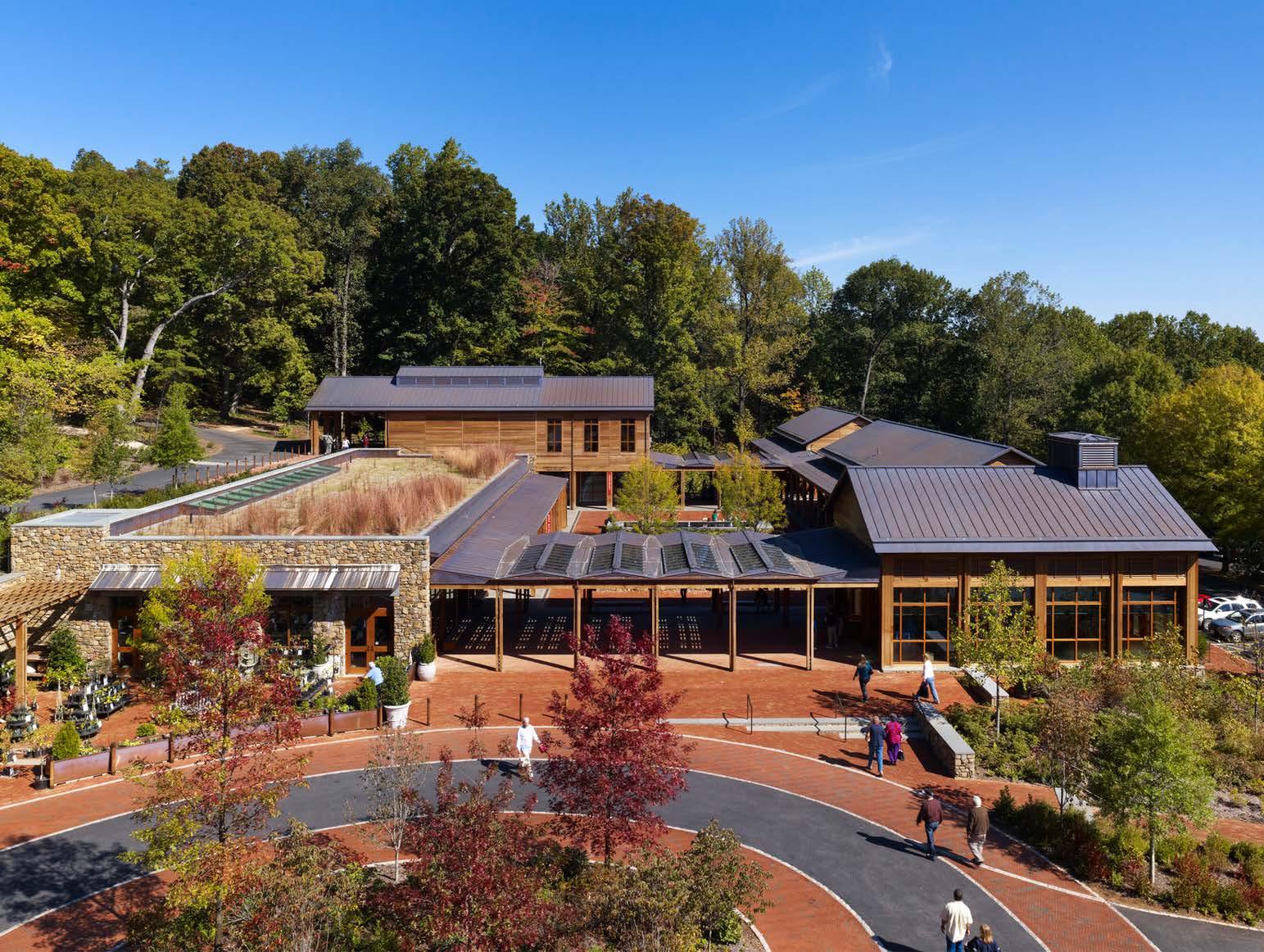


This project provides a memorable visitor experience that piques interest and encourages future visits.


Our interdisciplinary team brings a wide range of expertise to every project to work with our clients every step of the way. We help create powerful and inclusive visitor experiences that are grounded in a deep appreciation of place. Our respect for process and history helps to foster projects that inspire and delight, while supporting stronger, more connected communities.

Adam Bridge AIA, LEED AP Principal, Architecture

Mindy Dunn Associate Principal, Graphic Design

Amelle Schultz PLA, LEED AP Principal, Landscape Architecture

Glenn Neighbors AIA, LEED AP Principal, Architecture

Doug Satteson, AIA, CDT, LEED AP Associate Principal, Architecture

Michelle Kollmann NCIDQ, LEED AP Principal, Interiors

Neelab Mahmoud AIA Senior Associate, Architecture

Elizabeth McLean AIA Associate Principal, Architecture